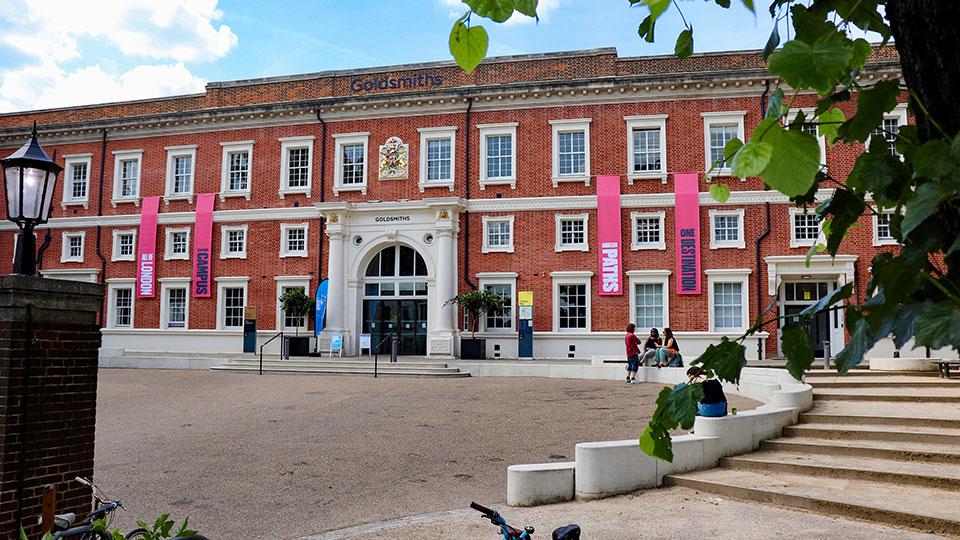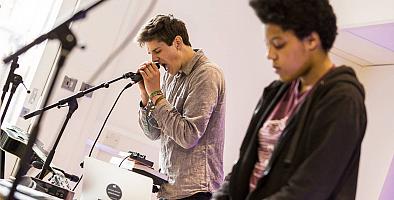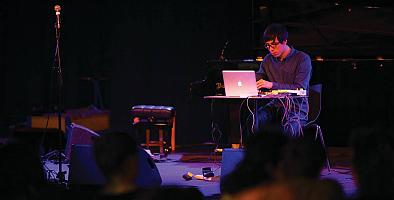BMus (Hons)
Music
Content navigation menu
Why study BMus Music at Goldsmiths
This degree reflects the diversity and excitement of music in the 21st century, and gives you the opportunity to mix performance, composition and research.
- In the first year you’ll explore different musical styles and approaches to study through a range of compulsory practical and critical modules.
- Later, you'll be able to choose from our wide range of jazz, sonic art, popular and film music modules as well as our practical, skills-based workshop and teaching modules.
- You’ll have lots of opportunities to perform, including in professional and student-led ensembles and groups such as Gamelan Ensemble, Sinfonia and Creative Jazz Ensemble, and at our annual music festival PureGold, which celebrates the music created and performed at Goldsmiths.
- We're within easy reach of central London’s many venues, concert halls, opera houses and research libraries, providing a great international focus.
- You’ll be very well set-up for the world of work. Employers look for initiative-driven graduates who think critically about their actions, work well with others and adapt quickly to new ideas. This degree will help you develop these skills.
- We attract instrumental and vocal teachers of the highest quality, with many of our staff also teaching at the major music conservatoires.
- Performance modules include one-to-one tuition on your main instrument/voice, as well as ensemble coaching, performance lectures and masterclasses from top professional musicians.
Contact the department
If you have specific questions about the degree, contact Paul Bartholomew.
UCAS code
W302
Entry requirements
A-level: BBB
BTEC: DDM
IB: 33 points overall with three HL subjects at 655
Length
3 years full-time, or up to 6 years part-time
Fees
Home - full-time: £9250
Home - part-time: £4625
International - full-time: £20160
Department
Watch videos about this course
What you'll study
Year 1 (credit level 4)
All BMus Music students take the following modules:
| Module title | Credits |
|---|---|
| Discovering Music | 30 credits |
| Performance | 30 credits |
| Composition | 30 credits |
| Materials, Signs and Symbols | 15 credits |
| Contemporary Music Industries | 15 credits |
Note about optional modules (if available): The above is indicative of the typical modules offered, but is not intended to be construed or relied on as a definitive list of what might be available in any given year. The module content and availability is subject to change.
Teaching style
This programme is taught through a mixture of scheduled teaching, including seminars, one-to-one tutorials and performance lessons, practical workshops and music studio sessions. You’ll also be expected to undertake a significant amount of independent study. This includes carrying out required and additional reading, preparing topics for discussion, and producing essays or project work.
How you'll be assessed
You’ll be assessed by a variety of methods, depending on your module choices. These may include coursework, examinations, group work, solo recitals, improvisation and group performances.
Entry requirements
We accept the following qualifications:
A-level: BBB
BTEC: DDM
International Baccalaureate: 33 points overall with three HL subjects at 655
UAL Extended Diploma: Merit overall
Access: Pass with 45 Level 3 credits including 30 Distinctions and a number of merits/passes in subject-specific modules
Scottish qualifications: BBBBC (Higher) or BBC (Advanced Higher)
European Baccalaureate: 75%
Irish Leaving Certificate: H2 H2 H2 H2
Additional requirements
A music qualification is recommended (eg UAL Extended Diploma, BTEC, A-level), but we will also consider those with substantial experience in performing, composition or theory.
Selection process
Candidates who have evidenced their academic, performance, and music theory qualifications in their UCAS applications may be made an offer at application stage.
We may also invite you to submit further evidence of your musical skills and abilities via a portfolio of work, or to a short interview with a member of the music department. We're looking for students who have the right blend of practical, creative and critical skills.
All offer holders will also be invited to an Applicant Day. This allows us to meet potential students and find out more about their interests and abilities.
International qualifications
We also accept a wide range of international qualifications. Find out more about the qualifications we accept from around the world.
If English isn’t your first language, you will need an IELTS score (or equivalent English language qualification) of 6.0 with a 6.0 in writing and no element lower than 5.5 to study this programme. If you need assistance with your English language, we offer a range of courses that can help prepare you for degree-level study.
Alternative qualifications
See our full list of undergraduate entry qualifications.
Fees and funding
Annual tuition fees
These are the UG fees for students starting their programme in the 2024/2025 academic year.
- Home - full-time: £9250
- Home - part-time: £4625
- International - full-time: £20160
If your fees are not listed here, please check our undergraduate fees guidance or contact the Fees Office, who can also advise you about how to pay your fees.
It’s not currently possible for international students to study part-time if you require a Student Visa, however this is currently being reviewed and will be confirmed in the new year. Please read our visa guidance in the interim for more information. If you think you might be eligible to study part-time while being on another visa type, please contact our Admissions Team for more information.
If you are looking to pay your fees please see our guide to making a payment.
Funding opportunities
We offer a wide range of scholarships and bursaries, and our careers service can also offer advice on finding work during your studies. Find out more about funding your studies with us.
Joe Brown Memorial Award
Second-year students are eligible to apply for an award of £1,000 towards final-year Creative Projects with an electronic component. Find out more about the Joe Brown Memorial Award
Additional costs
In addition to your tuition fees, you'll be responsible for any additional costs associated with your course, such as buying stationery and paying for photocopying. You can find out more about what you need to budget for on our study costs page.
There may also be specific additional costs associated with your programme. This can include things like paying for field trips or specialist materials for your assignments. Please check the programme specification for more information.
Careers
Careers for those with a music degree
Many of our graduates choose careers in fields related to their musical knowledge, such as:
- Teaching
- Performing
- Arts administration
- Music librarianship
- Publishing and retailing
- Record companies and production
- Technical work in radio or television
Statistically, music graduates demonstrate very good employment rates, because they are often highly trained in the kinds of transferable skills employers are seeking, such as individual motivation, team working and effective communication.
Find out more about employability at Goldsmiths.
Skills
You will develop specific musical skills including:
- Performance
- Composition
- Use of music technology
- Knowledge of a range of historical, contemporary, popular and world styles of music, and the debates and practices surrounding them
- Critical listening and score analysis
You'll also develop a wide range of key skills through both the practical and academic content of your degree, including:
- Communication (including public speaking, developing and presenting an argument, note taking, report writing)
- Analytical thinking
- Awareness of social, political and cultural processes
- Awareness of social and cultural difference
- Ability to take creative approaches
- Attention to detail
- Team work and collaborative practice
- The ability to undertake detailed research




